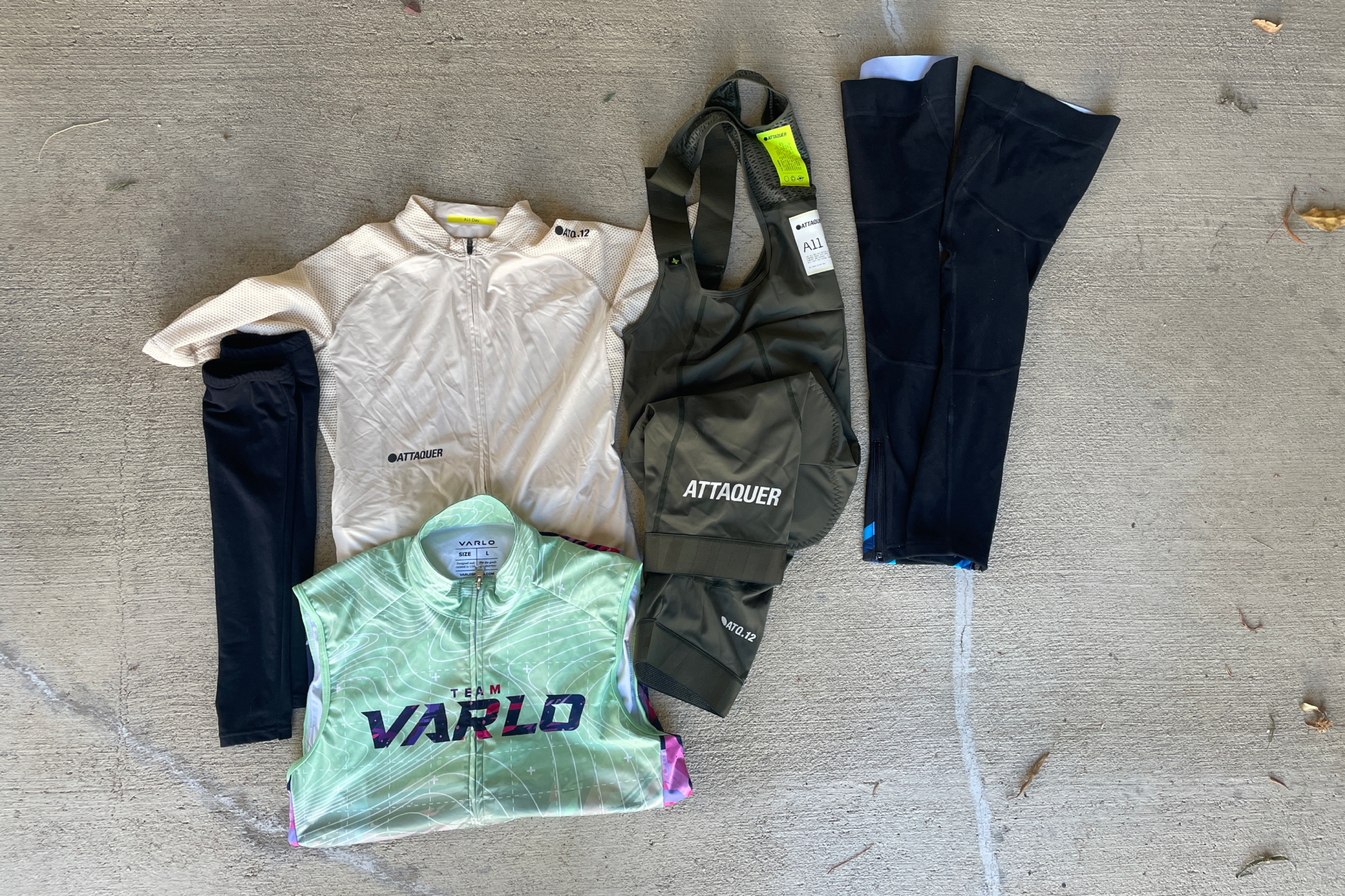What to wear cycling: A temperature-by-temperature cycling dress guide
Layer like a pro and stay comfortable year-round


Anne-Marije Rook
We’ve all been there. After obsessively checking the weather forecast, you stand in front of your closet, staring at your cycling gear. You weigh your options, hem and haw over which layers to wear. Will a base layer and light jacket suffice, or will you be shivering by mile ten? Should you start off in knee warmers or ditch them altogether? The wrong choice can lead to shivering descents or sweat-soaked climbs, quickly turning an enjoyable ride into a miserable slog.
Before you second-guess that extra layer—or leave one behind—turn to our temperature-by-temperature dress guide. It’s designed to help you get out of the door faster, and ride in comfort no matter the weather.
Disclaimer: Keep in mind that your riding environment and terrain can significantly impact how you experience temperature. Wind exposure, rain, ride intensity, and changes in elevation can all alter how warm or cool you feel during a ride. When in doubt, it’s always better to bring along an extra layer just in case —you can always shed a layer if you’re too warm, but if you’re underdressed, there’s no quick fix for the cold.
32°F and below

If you’re riding in temperatures below freezing, more power to you. But riding in such cold weather can bring a real concern for frostbite or hypothermia if you are not dressed correctly. As such, you’ll want to ensure you’ve got on a variety of layers that are windproof and potentially waterproof or water-resistant if snow or sleet is in the forecast.

Tops:
- Insulated, windproof and/or water-proof jacket. Even if it's not raining, a hardshell will go a long way in keeping the chilly air out.
The latest race content, interviews, features, reviews and expert buying guides, direct to your inbox!
Bottoms:
Accessories:
- Thermal neckwarmer (Buff) or balaclava
- Insulated gloves - “lobster-style” gloves may keep fingers warmer
- Skull cap that goes over your ears
- Neoprene shoe covers or even winter cycling shoes
- Wool socks or double up on regular pairs if needed
32-39°F / 0-4°C

For many, this range is the coldest they’ll consider venturing outdoors in, though many will have turned to indoor riding by then.
When the sun is out and there is no precipitation, this temperature range can actually feel quite refreshing - but only if you’ve got the right gear on.

Tops:
- Down-filled or insulated vest or jacket.
Bottoms:
Accessories:
- Skull cap that goes over your ears
- Neoprene shoe covers or even winter cycling shoes
40-49°F / 5-10°C

Once you get moving on your ride in the 40-49°F (5-10°C) range, you might even break a sweat. But with sweat can come post-sweating chills, so warm clothes are still needed to stay comfortable as you cruise along in these brisk temperatures.

Tops:
- Long-sleeve jersey (doesn’t need to be thermal)
Bottoms:
- Thermal bib tights or insulated bib shorts with lined legwarmers
Accessories:
- Thinner neckwarmer (Buff) - merino wool is a good option
- Thinner, but still full-fingered gloves
- Headband or cap (optional)
- Neoprene shoe covers
- Thinner wool socks - again, merino wool is a good option
50-59°F / 10-15°C

After a long, cold winter, nothing feels quite as good as the first sunny day that cracks 50°F (10°C). While temperatures in the 50s can still carry a chill in the shade, these early springtime conditions offer a welcome opportunity to start peeling off the heavy thermal layers you’ve depended on all winter. It might even be time to let those pale arms and legs soak up some long-missed sunlight.
However, dressing for this temperature range can be tricky—sunny skies can feel pleasantly warm, but overcast conditions can quickly cool you down. The best strategy? Bring plenty of layers and shed them as needed!

Tops:
- Non-thermal long-sleeve jersey
- Packable jacket or warm vest
Bottoms:
- Bib shorts with Leg warmers
- Or, non-insulated lycra-only bib tights like Ornot's Lightweight Tight or Velocio's Luxe Bib Tights
Accessories:
- Non-thermal neckwarmer or bandana (optional)
- Non-thermal full-fingered gloves
- Toe covers (optional)
60-65°F / 15-18°C

Spring has really sprung now! The 60-65°F ( 15-18°C) range is the first set of temperatures where you can truly feel “free” on the bike again, leaving your gloves, neck gaiters and toe covers at home.
But while this spring weather may feel pleasant in the sun and on the flats if you’re climbing and descending, be sure to pack a windproof vest to fend off the wee bit of chill that still remains at this temperature range.

Tops:
- Short-sleeve jersey with arm warmers (stash those when things warm up)
- Windproof vest or packable wind shell
Bottoms:
- Knee warmers (optional)
Accessories:
- Fingerless gloves (optional)
65-70°F / 18-21°C

The riding season is in full swing by the time the weather warms up to the 65-70°F ( 18-21°C) range. And breaking out the first short-sleeve jersey of the season is a great reward for slogging through all of that wet and cold weather.
You won’t need much other than a jersey and bibs at these temperatures, but it’s not a bad idea to bring a packable vest if you’re ascending to cooler temperatures or descending at rapid speeds.

Tops:
- Light baselayer (optional)
Bottoms:
Accessories:
70-80°F / 21-26°C

This may just be the most comfortable temperature range for cycling comfort without excessive sweating or needing to bundle up.
While you'll be perfectly comfortable in just a short-sleeve jersey and bib shorts, a mesh base layer will help regulate your body temperature and manage moisture. As you sweat, a wicking baselayer pulls moisture away from your skin and moves it to the outer layers of the fabric, where it can evaporate more quickly. This keeps you dry, reducing the risk of feeling clammy or chilled, especially during descents or stops.

Tops:
- Mesh baselayer (for wicking)
- Short-sleeve jersey
Bottoms:
Accessories:
- Fingerless cycling gloves (optional)
85°F+ / 30°C+

When the summer weather really start heating up, you’ll want to think just as carefully about your apparel choices as you did back in the days of frigid temperatures.
Opting for an ultra-light kit will help to keep you cool(er), and if you’re particularly sensitive to the sun’s UV rays, you may want to choose a long-sleeve summer jersey to protect your arms from sun exposure. Remember to apply sunscreen!

Tops:
- Summer sun protection arm sleeves or summer long-sleeve jersey (optional)
Bottoms:
Accessories:
- Fingerless cycling gloves (optional)

Kristin Jenny is an elite triathlete based near Boulder, Colorado. Although most of her time is spent in aerobars somewhere in the mountains, she finds time to enjoy eating decadent desserts, hiking with her husband and dog, and a good true crime podcast.
- Anne-Marije RookNorth American Editor